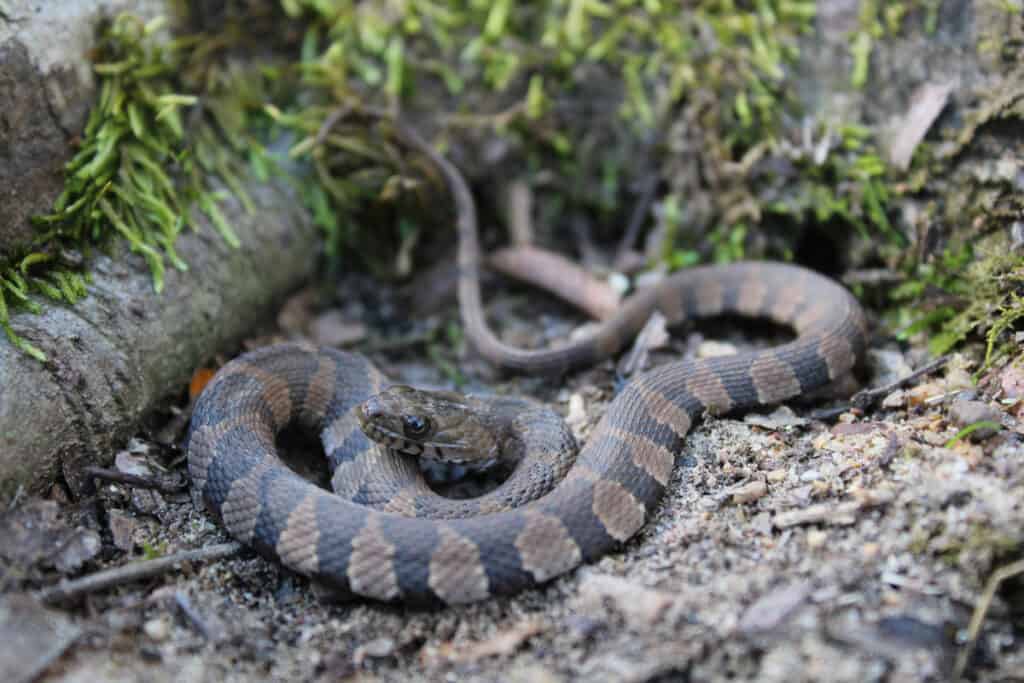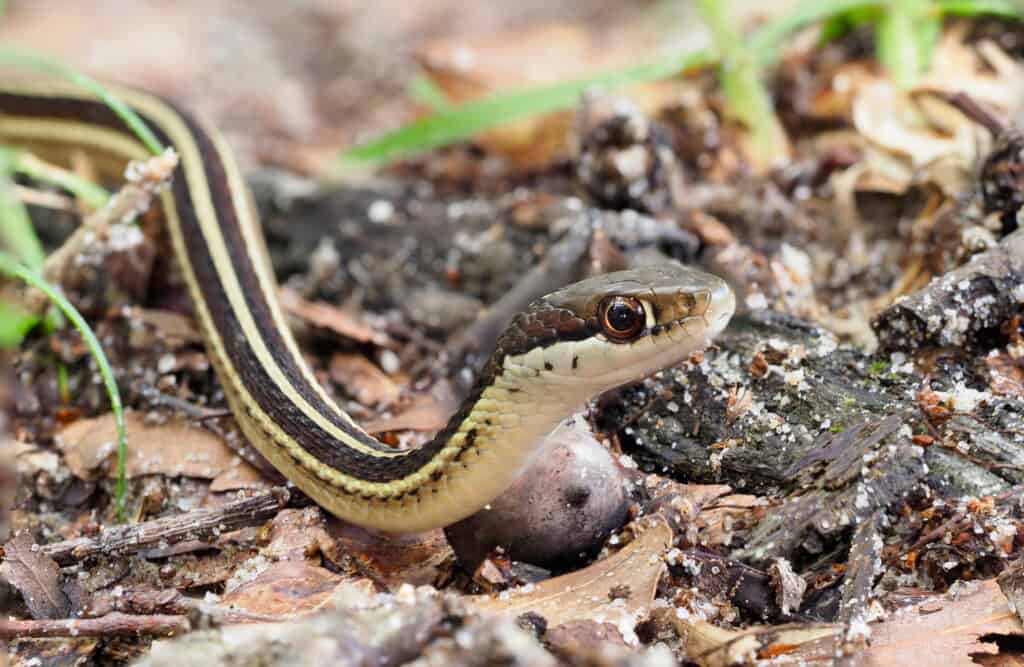New Hampshire is a small state located in the New England region. However, despite being small it is incredibly diverse, with numerous woodlands, mountains, and wetland regions. Wetlands, in particular, are teeming with wildlife — including snakes. That’s right, there are 11 species of snakes in New Hampshire and three of them can be found in its waters. So, in this article we’ll identify the water snakes in New Hampshire and highlight any that are dangerous. We’ll also find out what they look like, what they eat, and when they are most active.
1. Northern Water Snake (Nerodia sipedon)

The northern water snake inhabits most wetland regions in New Hampshire.
©Tucker Heptinstall/Shutterstock.com
The first snake on our list is the northern water snake which, as a member of Nerodia, is the only true water snake in the entire state. Northern water snakes are typically brown to dark brown with even darker crossbands and blotches. Sometimes they can have a very dark ground color and wide markings which make them appear to be almost completely black. However, their markings typically begin as crossbands in the neck region and then transition to large blotches near the tail. They are large snakes with a wedge-shaped head and reach approximately five feet long. Northern water snakes are frequently mistaken for cottonmouths and are sometimes killed as a result. However, it should be noted that the cottonmouth does not occur in New Hampshire.
Northern water snakes are widespread in New Hampshire and live in a variety of wetland habitats, such as streams, ponds, rivers, and swamps. They are powerful animals and prey on a wide variety of fish and amphibians which are all grabbed with their powerful jaws and teeth before being swallowed alive. Northern water snakes are not typically dangerous and prefer to flee back into the water if they are disturbed. However, they will strike as a means of defense if they are cornered and can inflict a painful bite. Although they are not venomous they do have a mild anti-coagulant in their saliva which causes wounds to bleed more than usual as it prevents the blood from clotting.
2. Eastern Ribbon Snake (Thamnophis saurita)

Eastern ribbon snakes are almost always found close to water.
©Steve Bower/Shutterstock.com
The next water snake in New Hampshire is the eastern ribbon snake which is a slender snake with a thin body and a long tail. Their tail makes up around one third of their total length which is approximately 18 to 36 inches. Eastern ribbon snakes are typically dark brown with three yellowish-colored stripes. One stripe runs down the center of their back while the other two run down either side of their body on the third and fourth rows of scales.
Eastern ribbon snakes are a vulnerable species within New Hampshire and are absent in the northern region. They live in wetland areas such as swamps, streams, and ponds. However, they can also be found in wet meadows and wet woodlands, although never far from water. Eastern ribbon snakes prey predominantly on amphibians and their main conservation threat come from anything which threatens the population of their prey.
Like the northern water snake, eastern ribbon snakes are ovoviviparous. This means that the females carry the eggs inside them until they hatch so they can give birth to live young. Mating takes place in the spring, shortly after the snakes awake from brumation. The young snakes are then born between July and September and are approximately seven to nine inches long.
3. Common Garter Snake (Thamnophis sirtalis)

Common garter snakes are dark-colored with three distinctive stripes.
©iStock.com/Wildnerdpix
Finally, we have the common garter snake which is often mistaken for the eastern ribbon snake. Common garter snakes attain lengths of up to 40 inches and although their color can vary they are typically dark brown. Like the eastern ribbon snake, these snakes have three distinctive yellowish stripes. However, their side stripes are located on scale rows two and three instead. They also lack the long tail that eastern garter snakes have. Common garter snakes also have a yellow belly and often have black or red spots or blotches between their light-colored stripes.
Common garter snakes occur statewide and live in a variety of habitats. However, they often inhabit areas close to water — such as swamps, marshes, ponds, stream edges, and wet woodlands. They are at home in the water and prey on a variety of aquatic and semi-aquatic animals, including fish, frogs, salamanders, and toads. They also prey on birds, lizards, and small rodents. Common garter snakes are mildly venomous, although not enough to be considered dangerous to humans. Instead, they contain a slight venom in their saliva which they chew into their prey. Although they are not naturally aggressive, bites from these snakes typically cause nothing worse than localized swelling and itching.
Common garter snakes are active from spring until October when brumation begins. They overwinter in burrows or rocky crevices and may be alone or in a communal den with other snakes. However, they may be spotted on warm winter afternoons as they typically emerge to bask.
The photo featured at the top of this post is © K Quinn Ferris/Shutterstock.com
Discover the "Monster" Snake 5X Bigger than an Anaconda
Every day A-Z Animals sends out some of the most incredible facts in the world from our free newsletter. Want to discover the 10 most beautiful snakes in the world, a "snake island" where you're never more than 3 feet from danger, or a "monster" snake 5X larger than an anaconda? Then sign up right now and you'll start receiving our daily newsletter absolutely free.
Thank you for reading! Have some feedback for us? Contact the AZ Animals editorial team.






